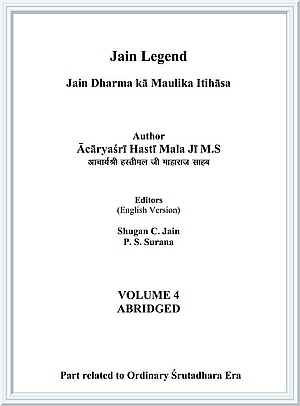According to Tapā gaccha Paṭṭāvalī, Lord Mahāvīra's 35th Pontiff, Ācārya Udyotana Sūri set out for Mount Arbuda in eastern India. Travelling through many places, he reached the border of 'Ṭelī village' on the foot hills of 'Mount Arbuda in eastern India. As the sun was setting, he halted in the forest itself under a very big pīpala tree for the night with the entourage of his disciples. They had completed the night austerities like expiatory recitals (pratikramaṇa), recitals, meditation, study of scriptures etc. At midnight Udyotana Sūri saw in the sky that Jupiter was entering into Rohiṇī constellation. Explaining the results of the planetary movements he said, "This is such an auspicious time that if I place my hand on anyone's head decorating him with any rank, his fame will reach far and wide and will remain eternally."
Immediately the disciples started entreating, "O Lord! Please have mercy on us. We you're your humble servants."
Udyotana Sūri ordained 84 disciples Sarvadeva Sūri, et al. as his successor ācāryas. Some historians are of the opinion that he appointed his chief disciple Sarvadeva Sūri as his successor ācārya. Since he bestowed ācārya rank upon his disciples under Vaṭa (pīpala) tree, the gaccha came to be known as Vaṭa gaccha.
As this gaccha consisted of many disciples and successors who imbibed the qualities of their preceptor, like matchless brilliance, profound knowledge, perception, conduct etc. and as the gaccha became astronomical in size with great number of monks and followers, it became famous as Vṛhad (very big) gaccha.
Thus, the fifth name of group of his followers became famous as Vaṭa or Vṛhad gaccha in Vikram 994, within a span of 1464 years, i.e. from the year of V.N. to V.N. 1464. The details of these 5 gacchas, like date of their origin, the ācāryas of that time period etc. are given below.
- From first year of V.N. to V.N. 291, i.e. from Ārya Sudharmā Swāmī, the first Pontiff of Mahāvīra to Ācārya Suhasti, the 10th successor Pontiff, the Congregation was called as Nirgrantha or Aṇagāra gaccha.
- After Ārya Suhasti in V.N. 291, Ārya Susthita and Ārya Supratibuddha (gaṇa Ācārya) succeeded as his successor Pontiffs. Under their regime, the congregation came to be known as 'Kauṭika gaṇa". Both of them chanted Sūri Mantra 10 million (Koṭi) times. Hence their gaccha became famous as Koṭi (Kauṭika) gaccha.
The second opinion is that Ārya Susthita and Supratibuddha were born in Kauṭika and Kākandika Nagarīs respectively. Susthita was senior in monkhood and older than Supratibuddha. So the congregation was called by the name of his native place Kauṭika-gaṇa, congregation or gaccha. The second name Kauṭika was prevalent from V.N. 291 to V.N. 611. - In V.N. 611, the group of followers came to be known as Candra gaccha, after the name of Ācārya Candra Sūri.
- During the tenure of Sāmantabhadra, the successor Pontiff of ācārya Candra Sūri, in V.N. 643, the congregation became famous as 'Vanavāsī gaccha'. Ācārya Sāmantabhadra was a true monk with total detachment and renunciation. He used to stay in desolated temples, maṭhas and in forests. Hence his gaccha gained popularity as Vanavāsa gaccha. The name continued from V.N. 643 to 1464.
- As already mentioned above, in V.N. 1464 during the period as pontiff of Sarvadeva Sūri, disciple of Udyotana Sūri, the tradition of Mahāvīra gained the name Vaṭa gaccha or Vṛhad gaccha.
The second opinion about Udyotana Sūri is that the disciples of Vanavāsī gaccha had no able monk to succeed (santati vihīna) to the rank of ācārya, though they were proficient scholars in scriptures. The different ācāryas of 83 gacchas (probably Temple dweller tradition) sent one disciple each from their gaccha to Udyotana Sūri to learn and acquire in-depth knowledge in scriptures. At the same time, Varddhamāna Sūri, the disciple of Jinacandra Sūri the head of Abohara temple left Temple dweller tradition, searching for a monk who follows the scripture based pure code of conduct and met Ācārya Udyotana Sūri. Impressed by his pure auspicious conduct and erudite scholarship in scriptures, Varddhamāna Sūri became his disciple. He too, along with other 83 disciples, started learning scriptures. Carrying out his religious tours with his 84 disciples, Udyotana Sūri reached the outskirts of Ṭelī village. As the sun was descending, they sojourned under a very big pīpala tree in the forest and started performing the night rituals and contemplation on religion (dharmārādhana) In the middle of the night they have observed that the Jupiter was entering into the Rohiṇī constellation. He said to his students, "It is such an auspicious time now that if I ordain anyone to any rank, his fame would reach far and wide and last forever and his gaccha would increase in leaps and bounds.
All the disciples and student monks requested, "Swāmī! We are your disciples. Please place your right hand on our heads and ordain us with ranks."
Udyotana Sūri said, "Bring me vāsacūrṇa (wood powder)". So the 84 student monks gathered small twigs and dry sticks, powdered them and gave to their guru. Consecrating the powder Udyotana Sūri placing his hand with the powder on each one of their heads, bestowed them the ācārya rank.
The next day realising that his last days were near, he observed fasting and left for heavenly abode in Samādhi.
Later, the 83 disciples, who were blessed with ācārya rank, went in different directions. Varddhamāna Sūri became the successor Pontiff of Udyotana Sūri.
The detailed description regarding this topic has already been given under the title 'Udyotana Sūri'.
 Acharya Hasti Mala
Acharya Hasti Mala
